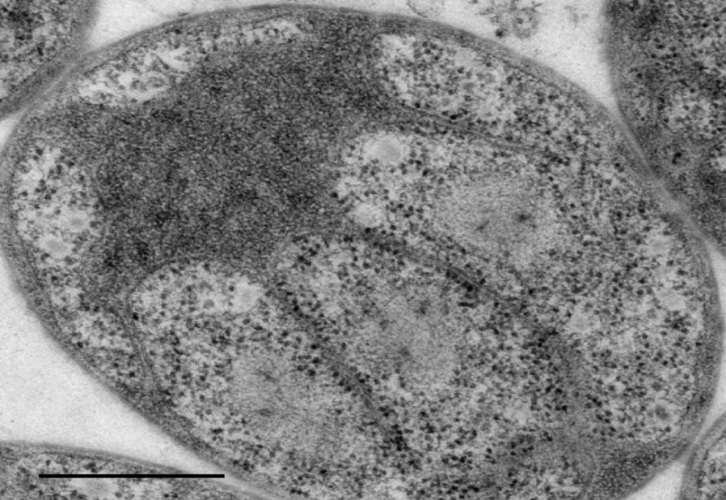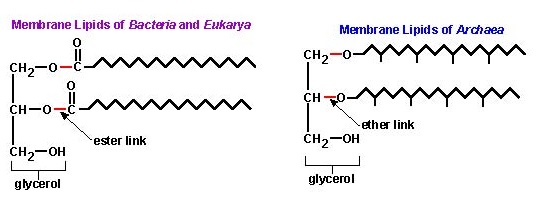Which Of The Following Is A Domain Consisting Of Protists, Fungi, Plants, And Animals?
1.iii: Classification - The Three Domain System
- Page ID
- 2699
Learning Objectives
- Define phylogeny.
- Proper name the 3 Domains of the 3 Domain system of classification and recognize a description of each.
- Name the four kingdoms of the Domain Eukarya and recognize a description of each.
- Define horizontal factor transfer.
The Earth is four.6 billion years sometime and microbial life is thought to have starting time appeared betwixt three.8 and 3.9 billion years ago; in fact, 80% of Earth'south history was exclusively microbial life. Microbial life is even so the dominant life form on Globe. It has been estimated that the total number of microbial cells on Earth on the order of 2.five X 1030 cells, making it the major fraction of biomass on the planet.
Phylogeny refers to the evolutionary relationships between organisms. The 3 Domain System, proposed past Woese and others, is an evolutionary model of phylogeny based on differences in the sequences of nucleotides in the cell's ribosomal RNAs (rRNA), also as the jail cell'due south membrane lipid structure and its sensitivity to antibiotics. Comparing rRNA structure is especially useful. Because rRNA molecules throughout nature bear out the aforementioned part, their construction changes very little over time. Therefore similarities and dissimilarities in rRNA nucleotide sequences are a good indication of how related or unrelated different cells and organisms are.
There are various hypotheses equally to the origin of prokaryotic and eukaryotic cells. Because all cells are similar in nature, it is generally idea that all cells came from a common ancestor cell termed the concluding universal common ancestor (LUCA). These LUCAs eventually evolved into 3 dissimilar cell types, each representing a domain. The three domains are the Archaea, the Bacteria, and the Eukarya.

More recently various fusion hypotheses accept begun to dominate the literature. I proposes that the diploid or 2N nature of the eukaryotic genome occurred afterwards the fusion of two haploid or 1N prokaryotic cells. Others propose that the domains Archaea and Eukarya emerged from a common archaeal-eukaryotic ancestor that itself emerged from a fellow member of the domain Bacteria. Some of the evidence behind this hypothesis is based on a "superphylum" of bacteria chosen PVC, members of which share some characteristics with both archaea and eukaryotes. In that location is growing evidence that eukaryotes may have originated inside a subset of archaea. In any issue, information technology is accustomed today that there are three distinct domains of organisms in nature: Bacteria, Archaea, and Eukarya. A description of the three domains follows.
Domains?
There is a "superphylum" of bacteria called PVC, referring to the three members of that superphylum: the Planctomycetes, the Verrucomicrobia, and the Chlamydiae. Members of the PVC, while belonging to the domain Bacteria, evidence some features of the domains Archaea and Eukarya.
Some of these leaner evidence cell compartmentalization wherein membranes surround portions of the cell interior, such as groups of ribosomes or Deoxyribonucleic acid, similar to eukaryotic cells. Some divide by budding or contain sterols in their membranes, again similar to eukaryotes. Some lack peptidoglycan, similar to eukaryotes and archaea. It has been surmised that these bacteria migh be an intermediate step betwixt an antecedent that emerged from a bacterium (domain Bacteria) and an archael-eukaryotic ancestor prior to its split into the domains Archaea and Eukarya.

The Archaea (archaebacteria)
The Archaea possess the following characteristics:
- Archaea are prokaryotic cells.
- Unlike the Bacteria and the Eukarya, the Archaea have membranes composed of branched hydrocarbon bondage (many also containing rings inside the hydrocarbon chains) attached to glycerol by ether linkages (Effigy \(\PageIndex{3}\)).
- The jail cell walls of Archaea contain no peptidoglycan.
- Archaea are not sensitive to some antibiotics that touch the Bacteria, just are sensitive to some antibiotics that affect the Eukarya.
- Archaea contain rRNA that is unique to the Archaea as indicated by the presence molecular regions distinctly different from the rRNA of Leaner and Eukarya.

Archaea oftentimes alive in extreme environments and include methanogens, farthermost halophiles, and hyperthermophiles. One reason for this is that the ether-containing linkages in the Archaea membranes is more than stabile than the ester-containing linkages in the Bacteria and Eukarya and are improve able to withstand higher temperatures and stronger acid concentrations.
The Bacteria (eubacteria)
Bacteria (also known equally eubacteria or "truthful leaner") are prokaryotic cells that are common in human being daily life, encounter many more than times than the archaebacteria. Eubacteria can be establish well-nigh everywhere and impale thousands upon thousands of people each twelvemonth, but as well serve as antibiotics producers and food digesters in our stomachs. The Bacteria possess the following characteristics:
- Leaner are prokaryotic cells.
- Like the Eukarya, they have membranes composed of unbranched fatty acid chains attached to glycerol by ester linkages (Figure \(\PageIndex{3}\)).
- The cell walls of Bacteria, dissimilar the Archaea and the Eukarya, comprise peptidoglycan.
- Bacteria are sensitive to traditional antibacterial antibiotics merely are resistant to almost antibiotics that affect Eukarya.
- Bacteria contain rRNA that is unique to the Bacteria as indicated by the presence molecular regions distinctly different from the rRNA of Archaea and Eukarya.
Bacteria include mycoplasmas, cyanobacteria, Gram-positive bacteria, and Gram-negative bacteria.
The Eukarya (eukaryotes)
The Eukarya (too spelled Eucarya) possess the following characteristics:
- Eukarya have eukaryotic cells.
- Like the Leaner, they take membranes composed of unbranched fatty acrid bondage fastened to glycerol by ester linkages (Figure \(\PageIndex{3}\)).
- Not all Eukarya possess cells with a cell wall, but for those Eukarya having a cell wall, that wall contains no peptidoglycan.
- Eukarya are resistant to traditional antibacterial antibiotics merely are sensitive to most antibiotics that bear on eukaryotic cells.
- Eukarya contain rRNA that is unique to the Eukarya as indicated by the presence molecular regions distinctly different from the rRNA of Archaea and Bacteria.
The Eukarya are subdivided into the following four kingdoms:
- Protista Kingdom: Protista are simple, predominately unicellular eukaryotic organisms. Examples includes slime molds, euglenoids, algae, and protozoans.
- Fungi Kingdom: Fungi are unicellular or multicellular organisms with eukaryotic cell types. The cells accept cell walls just are not organized into tissues. They do non deport out photosynthesis and obtain nutrients through absorption. Examples include sac fungi, club fungi, yeasts, and molds.
- Plantae Kingdom: Plants are multicellular organisms composed of eukaryotic cells. The cells are organized into tissues and take cell walls. They obtain nutrients by photosynthesis and absorption. Examples include mosses, ferns, conifers, and flowering plants.
- Animalia Kingdom: Animals are multicellular organisms equanimous of eukaryotic cells. The cells are organized into tissues and lack jail cell walls. They do not comport out photosynthesis and obtain nutrients primarily by ingestion. Examples include sponges, worms, insects, and vertebrates.
It used to be thought that the changes that permit microorganisms to adjust to new environments or alter their virulence capabilities was a relatively tiresome process occurring within an organism primarily through mutations, chromosomal rearrangements, factor deletions and cistron duplications. Those changes would and so be passed on to that microbe'south progeny and natural option would occur. This gene transfer from a parent organism to its offspring is called vertical cistron transmission.
It is at present known that microbial genes are transferred not only vertically from a parent organism to its progeny, but besides horizontally to relatives that are just distantly related, east.g., other species and other genera. This latter process is known equally horizontal gene transfer. Through mechanisms such as transformation, transduction, and conjugation, genetic elements such equally plasmids, transposons, integrons, and fifty-fifty chromosomal DNA can readily be spread from 1 microorganism to another. Equally a result, the old three-branched "tree of life" in regard to microorganisms (Figure \(\PageIndex{1}\)) now appears to exist more of a "net of life."
Microbes are known to live in remarkably various environments, many of which are extremely harsh. This amazing and rapid adaptability is a result of their ability to chop-chop modify their repertoire of protein functions past modifying, gaining, or losing their genes. This gene expansion predominantly takes place past horizontal transfer.
Summary
- Phylogeny refers to the evolutionary relationships between organisms.
- Organisms can be classified into ane of 3 domains based on differences in the sequences of nucleotides in the cell'south ribosomal RNAs (rRNA), the jail cell's membrane lipid structure, and its sensitivity to antibiotics.
- The three domains are the Archaea, the Bacteria, and the Eukarya.
- Prokaryotic organisms belong either to the domain Archaea or the domain Leaner; organisms with eukaryotic cells belong to the domain Eukarya.
- Microorganism transfer genes to other microorganisms through horizontal gene transfer - the transfer of DNA to an organism that is not its offspring.
Source: https://bio.libretexts.org/Bookshelves/Microbiology/Book:_Microbiology_%28Kaiser%29/Unit_1:_Introduction_to_Microbiology_and_Prokaryotic_Cell_Anatomy/1:_Fundamentals_of_Microbiology/1.3:_Classification_-_The_Three_Domain_System
Posted by: zanderspronful1972.blogspot.com

0 Response to "Which Of The Following Is A Domain Consisting Of Protists, Fungi, Plants, And Animals?"
Post a Comment